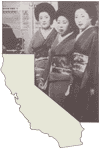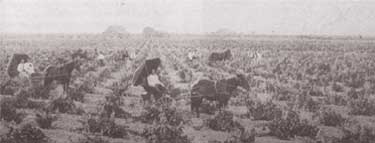![]()

Five Views: An Ethnic Historic Site Survey for California
MENU
Introduction
Immigration
Settlement
Organizations/Religion
Discrimination
World War II Incarceration
Historic Sites
Selected References

A History of Japanese Americans in California:
HISTORIC SITES
Bowles
Fresno County
Bowles, as defined by the Japanese, is a farming community in Fresno County totally populated by Japanese Americans. Although maps show a town called Bowles on the Santa Fe Railroad tracks south of Fresno, the Japanese say there are two — the one on the map and the Japanese Bowles. The Bowles the Japanese settled is located a few miles further west of Manning Avenue, and there is no designation on the map that this is a community. This area was referred to as Bowles because mail delivery did not go directly out to the farms. Mail would arrive on the train at the railroad stop in Bowles, and farmers would go to the Bowles train stop to pick up their mail. Now the mailing address for this community is Fresno, but Japanese still refer to the community as Bowles.
The Japanese Bowles is located in the area bounded on the east by Chestnut Avenue, on the west by Raisin City, on the north by Central Avenue, and on the south by Dinuba Avenue. It is almost totally farmland — grapes and tree fruit — with the Buddhist Church serving as the community center. No business section is associated with this Bowles.
It is said that the first Japanese came to Bowles to work for the Santa Fe Railroad Company, which had camps in Oleander and Bowles. Farmland around the railroad tracks was already settled by Swedish and Danish immigrants, and the only available land was west of Highway 41. In 1902-03, the first Japanese bought property in this area. The original families to plant vineyards were Nakagawa and Ninomiya; previously, land in agricultural production had been used to grow barley and other grain crops.
Japanese settlement of this area was stimulated by Rev. Fukyu Asaeda, who assisted in purchasing 160 acres of farmland located at Floral and Walnut avenues. By 1910, 28 families owned about 1,450 acres; and by 1920, 90-100 Japanese families owned about 3,500 acres.
A community center was built in 1914 for the Japanese-language school, religious services, lectures, and organizations such as the Young Men's Association. This latter organization participated in baseball, sumo, oratorical contests, and lectures. In 1921, the community built its first Buddhist Church; a new church was erected in 1966.
To finance the purchase of their farms, issei either saved money or obtained loans from one of several Japanese American banks or other lending institutions. One source indicates that Japanese farmers in the Bowles area were considered good financial risks and had no trouble obtaining loans.
After the Alien Land Law of 1913 passed, farms were purchased by issei through formation of corporations in which White friends, acquaintances, or professionals were paid a small sum of money to serve as boards of directors. In some cases, land was purchased in the name of nisei children.
Once land was acquired, it was most beneficial if farmers had a family to help on the farm. Another common arrangement was for brothers to operate a farm together. Occasionally, two friends would jointly buy property, with one working the farm and the other working at another job (in addition to the farming) to have working capital.
Whereas in other parts of the state Japanese farmers formed their own cooperatives, Japanese in Bowles did not, because existing organizations welcomed and solicited issei participation. For example, it has been said that the Raisin Association welcomed Japanese growers because they needed 40 to 55 percent of all raisin producers to bargain for higher prices. Japanese farmers committed their crops to this association but stayed in the background. It is generally agreed that a major reason for the success of the Raisin Association was the role of the issei in its early years.
In 1933, most Japanese farmers in this area had financial difficulties, and 95 percent of them lost their land to the banks. An estimated 40 to 55 percent of the people moved out of Bowles to Southern California. The rest worked as day laborers until they were able to accumulate enough capital to buy back the land.
Interestingly enough, banks found holding these farms for six months unprofitable during the Depression, and many issei farmers were able to buy back farms previously worth $10,000 for $3,000-4,000.
During the World War II internment, many Japanese leased their farms to non-Japanese friends, while a few sold them. On return to their homes, Japanese community members of Monmouth and Oleander joined the Bowles Buddhist Church to become one community, although they had previously had their own churches and organizations.
The acreage owned by Japanese farmers in 1979 was close to 4,000 acres, with additional leased land. Bowles is still a farming community without business establishments, and the center is still the Buddhist Church. Any necessary business is conducted in Fresno, Fowler, or other neighboring towns. The major crop of the Bowles farms is still grapes made into raisins. Table grapes, winery grapes, tree fruit, and cotton are also crops of this community. Many of the families that first settled in Bowles remain active members of the community; a few sansei, third-generation Japanese, also work the farms.

Bowles, Fresno County [circa 1910]
NEXT> Concord Nippongo Gakko
Last Modified: Wed, Nov 17 2004 10:00:00 pm PDT
http://www.cr.nps.gov/history/online_books/5views/5views4h10.htm
![]()
 Top
Top